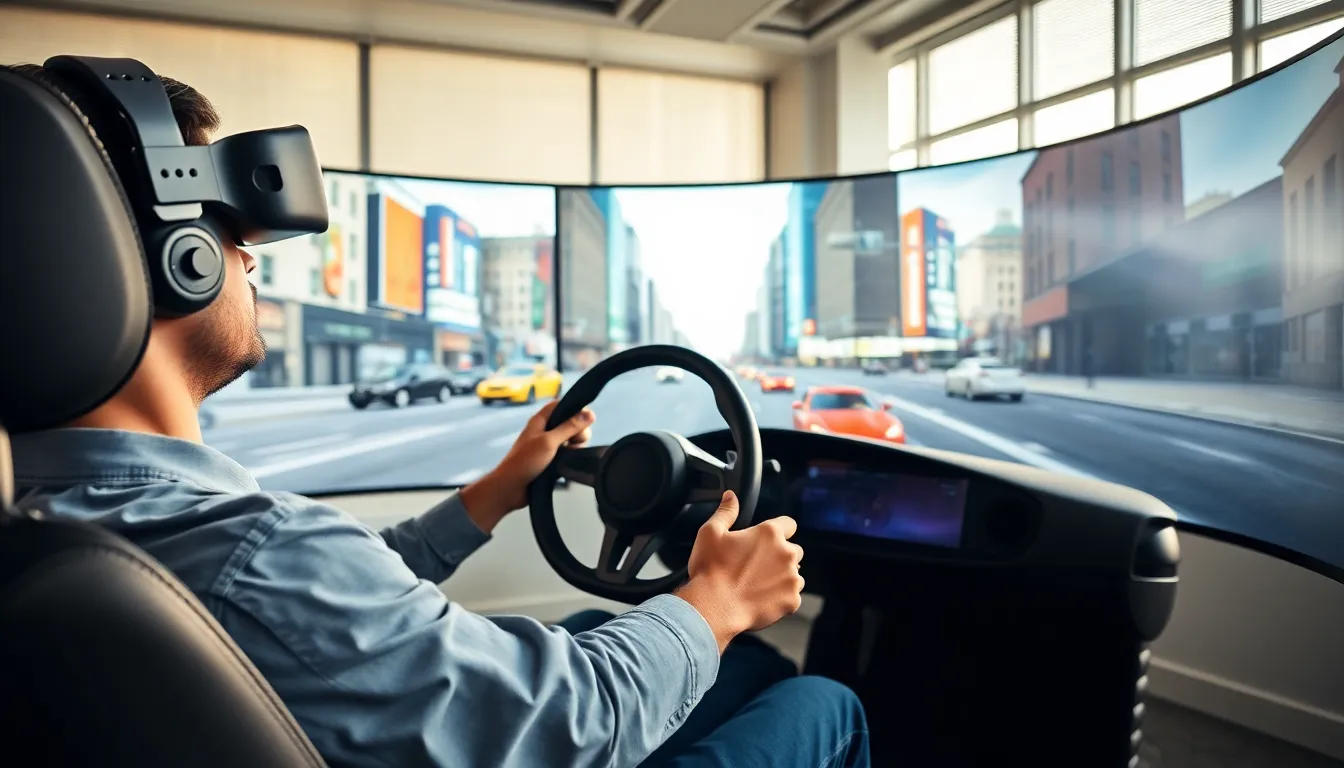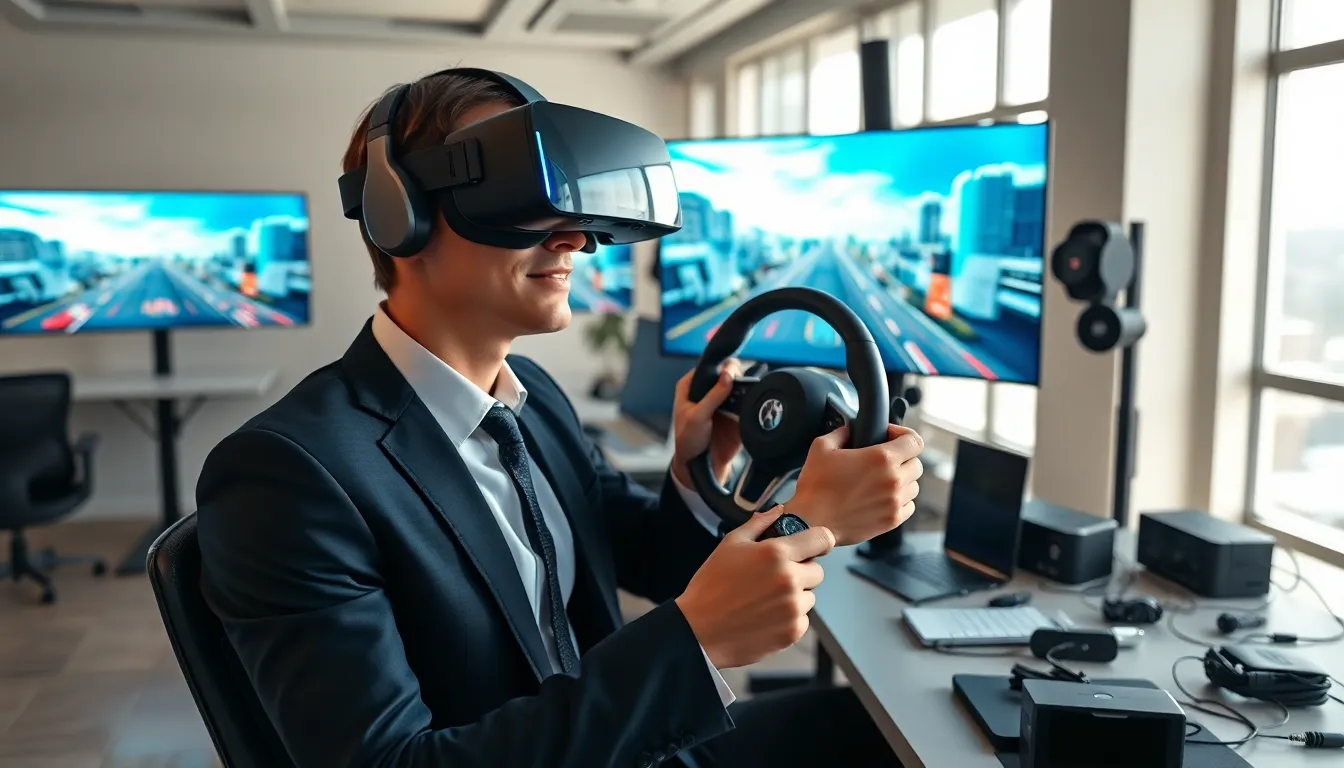The world of driving is speeding toward a new horizon, and at the forefront of this transformation are VR driving simulators. Imagine a world where you can hit the streets without ever leaving your living room. With a headset on, you’re not just a spectator but a participant in a thrilling, immersive experience that mimics real-world driving scenarios. Whether for training, fun, or research, VR driving simulators are quickly becoming the ‘go-to’ technology for redefining how we engage with driving. Buckle up as we jump into this exciting subject.
Table of Contents
ToggleUnderstanding VR Driving Simulators

VR driving simulators are innovative tools that use virtual reality technology to create realistic driving experiences. By incorporating 3D graphics, motion controls, and sensory feedback, these simulators transport users into a virtual environment that accurately mimics real-world driving conditions. It’s like stepping into a new world where users can navigate through bustling city streets or serene country roads, all from the comfort of their own space.
The core technology behind these simulators typically involves a combination of high-quality visual displays, positional tracking systems, and responsive controls. The result? A level of immersion that traditional simulators simply cannot match. Whether it’s experiencing the fine nuances of driving in bad weather or maneuvering through tight spaces, VR driving simulators bring a dynamic edge to learning and entertainment alike.
Key Features of VR Driving Simulators
Several standout features make VR driving simulators an appealing choice for both casual users and professionals.
Immersive Environments
The 3D graphics in these simulators create lifelike environments. From pedestrians crossing the street to traffic lights changing colors, every detail counts.
Real-time Feedback
Users receive immediate feedback on their driving performance. Whether it’s a gentle nudge when going off-road or an alert when approaching a stop sign, this instant feedback is invaluable for skill development.
Customizable Settings
Drivers can choose different vehicles, weather conditions, and terrain types, ensuring a tailored experience that meets individual preferences and skill levels.
Multi-User Capability
Many VR driving simulators allow for multiplayer options, letting friends compete against each other in an exhilarating race, or collaborate in scenarios like emergency driving conditions.
Motion Simulators
Some advanced setups even equip users with motion platforms, giving them a physical sensation of turning, accelerating, or braking that goes beyond visual simulation.
Benefits of Using VR Driving Simulators
The benefits of utilizing VR driving simulators extend beyond just enjoyment. They play a crucial role in training and education as well.
Safety
First and foremost, these simulators provide a safe space for learning. Users can practice essential driving skills without the risks associated with real-life driving, making it an excellent tool for novice drivers.
Skill Acquisition
From parallel parking to navigating through a busy intersection, VR driving simulators help the mastery of complex skills that can be challenging to learn in a traditional setting.
Cost-Effective Training
Organizations focused on driver training can save significantly on costs related to real vehicles and fuel. With VR driving simulators, the need for an expensive fleet is diminished, allowing institutions to focus resources elsewhere.
Accessibility
Individuals with disabilities or those unable to get behind the wheel can still engage in driving simulations, broadening access to driving experiences.
Applications of VR Driving Simulators
The applications of VR driving simulators are numerous and varied, appealing to a wide spectrum of users.
Driver Education
Schools and driving institutions have embraced VR driving simulators as an integral part of their curriculum. Offering students a risk-free environment to hone their skills ensures a high-quality learning experience.
Research and Development
Automakers and researchers use these simulators to conduct tests and gather data on driver behavior under various conditions, greatly benefiting vehicle design and safety features.
Entertainment
Gamers flock to VR driving simulators for a unique and thrilling experience. Various platforms offer racing games, where users can experience the competitive thrill of racing against friends or AI opponents.
Emergency Training
Emergency responders can simulate crisis scenarios, like navigating through traffic during a disaster, allowing them to develop strategies and improve response times in real-world emergencies.
Choosing the Right VR Driving Simulator
Selecting the ideal VR driving simulator can be a bit overwhelming given the variety of options on the market. Here are a few tips to narrow down the choices:
Define Your Purpose
Identify whether the simulator is primarily for educational purposes, entertainment, or professional training. Understanding the intended use helps in making an informed choice.
Budget Considerations
VR driving simulators range from affordable to high-end models. Set a budget before exploring options to ensure you’re considering the right products.
Read Reviews
Online reviews and user testimonials provide valuable insights into the performance and reliability of specific simulators. Always check for feedback from credible sources.
Test Before You Buy
Whenever possible, visit a store that allows you to test drive different simulators. Experience firsthand how they feel and how responsive the controls are before making a purchase.
Future Trends in VR Driving Simulation Technology
The world of VR driving simulators is constantly evolving, and some exciting trends are beginning to emerge.
Integration with AI
Artificial Intelligence is playing a pivotal role in enhancing driving simulations by creating dynamic scenarios that react to user actions. This personalization makes each driving experience unique and adaptive.
Enhanced Sensory Feedback
Advancements in haptic technology promise more realistic sensations, such as the vibration of the car as it accelerates or the resistance felt when steering. Such improvements offer a more authentic representation of driving.
Increased Realism
As graphics technology improves, users can expect even more lifelike environments that can replicate anything from busy urban settings to quiet rural roads. This heightened realism will make the driving experience even more engaging.




